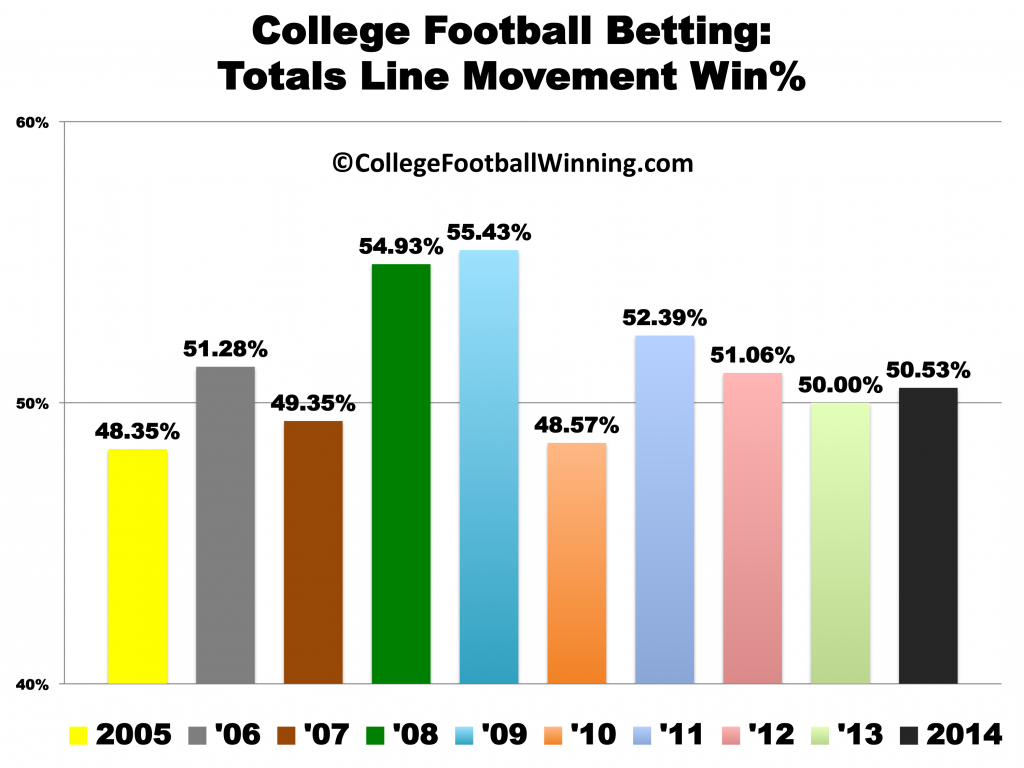Using Totals Line Movement for College Football Predictions
In a previous article, we examined college football predictions through the lens of point spread line movement (i.e. the change or difference between the opening point spread and the closing point spread). In this article, we turn our attention to making “Totals” (often known as “Over/Unders”) college football predictions based on their line movement (from the opening Total to the closing Total). As we mentioned in that previous article, the movement of a betting line, be it spreads or Totals, is the subject of a lot of handicapping attention. Whether a professional bettor or handicapper discusses betting line movement explicitly or emphasizes the importance of “beating the market” by placing (or recommending) a bet before the line moves, line movement is generally regarded as a critical element in making college football predictions (and possibly all sports betting predictions). The question this article attempts to answer is: Just how important is line movement (if important at all) for predicting the outcome of college football Totals?
Totals Line Movement Defined
For this study, we used opening and closing Totals betting lines to gauge how often that direction (from opening to closing Total) indicated the correct betting outcome. Consider the following example: The opening Total for the 2015 College Football National Championship game between Oregon and Ohio State was 74. The closing Total was 72.5. Since the Total went down, the line movement suggested that the Under was the right side (or the correct bet). Since the game ended with a combined 62 points, the Under was the correct side. Therefore, the Totals line movement did, indeed, suggest the correct side.
Totals Line Movement Facts
From 2005 to 2014, closing college football seasons Totals differed from the opening Totals in nearly 88% of all college football games. Examining just the 2014-2015 college football season, that figure was at 86.3%, so it should be noted that most college football Totals do not end up where they began. For the purposes of this study, we excluded all games whose Totals opened and closed at the same number (even though many of those Totals “jumped-around” between their opening and closing positions). Although, for the past 10 seasons, the opening and closing Totals differed more than 12% of the time, the outcome was different (betting the opening Total versus betting the closing Total) just 5.23% of the time.
Totals line movement for college football predictions over the past 10 seasons indicated the correct betting outcome 51.21% of the time. The graph below illustrates, by year and percentage, the accuracy of Totals college football predictions as suggested by line movement:

Conclusion
It is important to remember that, in the sports-betting world of bet-11-to-win-10, the breakeven point is 52.38%. Based on 10 years of college football Totals data, line movement was not a very good indicator of Totals betting outcomes. In statistics terms, the average accuracy of predicting college football Totals outcomes through line movement in each of the past 10 seasons is within one standard deviation of the mean, with the exception of one year, 2009, and that was just 0.43% outside of one “?.” It is, therefore, the conclusion of this study that using Totals line movement for college football predictions is not a profitable betting strategy.


Warning: count(): Parameter must be an array or an object that implements Countable in /home/colleg63/public_html/wp-includes/class-wp-comment-query.php on line 399